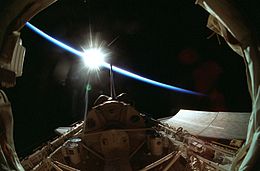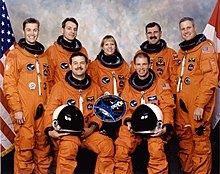STS-90

Spacelab in Columbia’s payload bay during the STS-90 mission
|
|||||
| Mission type | Bioscience research | ||||
|---|---|---|---|---|---|
| Operator | NASA | ||||
| COSPAR ID | 1998-022A | ||||
| SATCAT № | 25297 | ||||
| Mission duration | 15 days, 21 hours, 50 minutes, 58 seconds | ||||
| Distance travelled | 10,000,000 kilometres (6,200,000 mi) | ||||
| Spacecraft properties | |||||
| Spacecraft | Space Shuttle Columbia | ||||
| Landing mass | 105,462 kilograms (232,504 lb) | ||||
| Payload mass | 10,788 kilograms (23,783 lb) | ||||
| Crew | |||||
| Crew size | 7 | ||||
| Members |
Richard A. Searfoss Scott D. Altman Dafydd Williams Kathryn P. Hire Richard M. Linnehan Jay C. Buckey James A. Pawelczyk |
||||
| Start of mission | |||||
| Launch date | 17 April 1998 18:19 UTC | ||||
| Launch site | Kennedy LC-39B | ||||
| End of mission | |||||
| Landing date | 3 May 1998 16:09 UTC | ||||
| Landing site | Kennedy SLF Runway 33 | ||||
| Orbital parameters | |||||
| Reference system | Geocentric | ||||
| Regime | Low Earth | ||||
| Perigee | 247 kilometres (153 mi) | ||||
| Apogee | 274 kilometres (170 mi) | ||||
| Inclination | 39.0 degrees | ||||
| Period | 89.7 min | ||||
|
|
|||||


Left to right - Front row: Altman, Searfoss; Back row: Pawelczyk, Linnehan, Hire, Williams, Buckey
STS-90 was a 1998 Space Shuttle mission flown by the Space Shuttle Columbia. The 16-day mission marked the last flight of the European Space Agency's Spacelab laboratory module, which had first flown on Columbia on STS-9, and was also the last daytime landing for Columbia.
Neurolab was a Spacelab module mission focusing on the effects of microgravity on the nervous system. The goals of Neurolab were to study basic research questions and to increase the understanding of the mechanisms responsible for neurological and behavioral changes in space. Specifically, experiments would study the adaptation of the vestibular system and space adaptation syndrome, the adaptation of the central nervous system and the pathways which control the ability to sense location in the absence of gravity, and the effect of microgravity on a developing nervous system.
The mission was a joint venture of six space agencies and seven U.S. research agencies. Investigator teams from nine countries would conduct 31 studies in the microgravity environment of space. Other agencies participating in the mission included six institutes of the National Institutes of Health, the National Science Foundation, and the Office of Naval Research, as well as the space agencies of Canada, France, Germany, and Japan, and the European Space Agency.
...
Wikipedia
